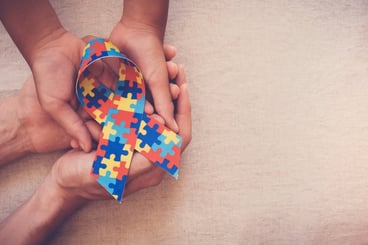
What are some of the myths about autism, where do these myths come from, and how do they affect children, families, teachers, and therapists? By identifying the myths, we can challenge them through accurate information and education, as well as public policy.
For the purposes of this article, “myth” will be defined as a widely-held belief that is not supported by evidence, one that is based on incomplete or inaccurate information, or the inappropriate application of a belief. The intersection of psychology and myth has been termed “psycho-mythology”1 and may be one of the most powerful forms of myth because it pertains to our health and well-being. The most believable myths begin with some small taste of fact and then build an explanatory framework that is not factual. Some myths are positive, but unfortunately, most are negative and hurtful. Belief in such myths tends to cause the believer to engage in specific kinds of interactions and intentions towards individuals that may have adverse effects.
Myth 10: Most autistic people must be institutionalized; they can’t live independently.
It is not unusual for the general public to view autistic persons as chronically disabled, low- or non-functional, and dependent on others for survival.2 The 1988 film, Rain Man, starred Dustin Hoffman as an autistic man living in an institution; he had been placed there by his parents due to their fear that he would harm his infant brother (we will talk more about the myth of autistic persons as dangerous a bit later). This is not an uncommon portrayal. The implication and generalization is that an autism diagnosis immediately constitutes a cause for institutionalization, and a past generation of physicians advised parents to do exactly that. The misperception was that autism automatically meant mental retardation (to use the old term), and an inability to function independently. Although there are autistic persons with additional disabling conditions who are unable to function without significant support and supervision, we now know that this myth is largely false.

Myth 9: Autistic people are uneducable; therefore, they are unemployable and a drain on society.
While some autistic persons also have intellectual disabilities, some are “twice exceptional”: both autistic and gifted. Interestingly, a common misperception is that all autistic persons have learning disabilities.3 While some may have specific learning disorders, some have no such difficulties. Combined with the perspective noted above, it is not surprising that these same people hold the misconception that autistic persons are unemployable. A 2017 study found that 61.42% of autistic adults were employed and 38.58% were unemployed.4 The U.S. Department of Labor acknowledges that autistic persons face greater challenges with employability and under-employment, and has identified some resources to help both employers and applicants.5 While many employers welcome autistic employees, not all do; but certainly, this data shows that progress is being made in debunking this myth. Recently, some employers have started actively recruiting from the autism community, recognizing that there are sometimes characteristics found in autistic individuals that are suitable for specific types of work.
Myth 8: Autistic people are idiot-savants; they are mentally deficient in some ways, but have genius abilities in math and music or some other special talent.
It will come as a surprise to no one that movies and television tend to exaggerate the personal qualities of the characters they portray. The 1988 film Rain Man, referenced above, portrayed an individual who had amazing abilities to remember specific baseball data from multiple decades past, and who could instantly and intuitively count a pile of objects that would take a neurotypical person an hour or more. This portrayal led a generation of movie-goers to believe that every autistic person has incredible capabilities in mathematics, memorization, or conceptual thinking. In fact, only about 10% of autistic persons have savant skills.6 And that 10% is impressive! Social media is not immune to the exaggeration syndrome; this kind of myth gets widely “shared” and amplified; and when a consumer reads the same incorrect information repeatedly, they begin to believe it must be true.

Myth 7: Those repetitive behaviors are a sign of Obsessive-Compulsive Disorder (OCD), not Autism Spectrum Disorder (ASD).
While there is an overlap in the appearance of persistent repetitive behaviors, in OCD the behavior is propelled by underlying thoughts. The intrusive, unwanted thoughts characteristic of OCD are called obsessions; the behaviors are called compulsions. In some autistic persons, the unusual behaviors are evident -- such as repetitive rocking, arm-flapping, and ordering of objects -- but don’t appear to be driven by underlying obsessions. According to a 2014 study,7 the repetitive behaviors in OCD are generated in order to avoid or decrease anxiety; in ASD, the behaviors bring some measure of comfort or pleasure. For example, a person with OCD might wash their hands 100 times per day; this does not give them pleasure, and many state that they dislike it, but “I have to do it.” Such behavior may create cracking and bleeding of the skin, but the behavior decreases the sufferer’s anxiety. In ASD, the stereotyped behavior is performed because “it feels good; I like it.”
Myth 6: Autistic people are highly introverted loners; they don’t really like people and especially hate to be touched.
Here we need to distinguish between social motivation and social skills. While it is accurate that many autistic people struggle with social interaction skills and communication, in particular non-verbal decoding, this doesn’t mean that they don’t want to have friends and socialize.
“Although autistic people are often interested in forming relationships, their social communication challenges may result in problematic social interactions with neurotypical individuals and negative social experiences including loneliness, bullying, shunning, and stigmatization are common.”8 Further, “Negative stereotypes about autism were associated with lower levels of willingness to interact with autistic people.”9 In particular, individuals were reluctant to engage with autistic persons due to the behaviors associated with ASD. Thus we see that some non-autistic persons avoid those they perceive as autistic. This becomes a chicken-and-egg circumstance: are autistic persons loners because others avoid them, or because they prefer it? Clearly, in the majority of cases, autistic persons are isolated due to marginalization and rejection.
In an intra-family context, the same myth survives. One researcher recalled talking with a parent: “The mother was adamant that the boy couldn’t be autistic because he liked hugs and the mother’s impression was that it could not be possible if he was autistic.”10 Like most people, autistic persons may prefer physical contact with people they know and trust; it is unlikely that an autistic person will run around giving hugs to random strangers.
One researcher makes the point that the firmly-held view that autistic persons are non-social is due to the fact that autistic persons have not been included in the research; that is, they are studied but not allowed to actively contribute to the research.11 Thus, myths are sometimes generated by flawed research and perpetuated in the same manner. A wide variety of degrees of sociability exists across the human species; why would we not embrace the fact that autistic persons may have a high degree of sociability, a low degree, or any point in between?
Myth 5: “They’re all the same.” Autistic people are all exactly alike; if you’ve seen one you’ve seen them all.
Vast generalizations are harmful. This is an example of employing a myth more widely than is appropriate, such as a statement that “all autistic people flap their arms.” Nothing could be further from the truth. This mythology is also a stereotype, tossing all people into one category based on the appearance of a single characteristic. The danger with stereotypes, of course, is that one size fits almost no one, and this can be damaging to everyone involved. The current diagnostic profile of autism as occurring along a spectrum contradicts the assumption that “they’re all alike.”

Myth 4: Autism doesn’t really exist; the problem is caused by poor parenting.
Historically, research into mental disorders sometimes took the route of simplistic parent-blaming. Particularly with regard to serious and persistent mental illnesses, the mythology was simple: it was always the mother’s fault. In examining the very serious illness of schizophrenia, researchers (several decades ago) came up with the term, “schizophrenogenic mother.” That is, the mother caused schizophrenia in her child. Positive parenting practices were ignored, and the symptoms of schizophrenia were somehow believed to be caused by as-yet-unidentified parenting practices. Mothers everywhere can relate to the harm caused by this unfair demonization!
The stigma of any mental disorder means that ignorance combined with prejudice does harm to vulnerable people. Specifically, “parents of autistic children felt stigmatized by members of the general public, describing that they felt judged when their child presented with behaviors associated with autism.”12 Further, the same prejudice occurred even with family, friends, and neighbors who held inaccurate beliefs about autism. The stigma was not solely focused on the autistic child but on the entire family.
This brings up another even older myth about all mental illnesses. Readers have probably heard the phrase “the sins of the fathers shall be visited upon their children” or some similar iteration from the Bible. In the Middle Ages and later, any mental illness was believed to be due to either demonic possession or parental sinfulness, and it became “your cross to bear” just as Christ had to carry the literal cross of his crucifixion through the streets before he was nailed to it. In other words, autism was assigned to your child due to your sinfulness, and you just needed to accept your punishment. Thank goodness we have moved far beyond this idea!
Myth 3: Autistic people are dangerous; they will act aggressively for no apparent reason.
This is a common belief that has emerged in various studies. Many people believe that persons with mental disorders are more violent than others. A sub-part of the myth is that autistic persons are stronger than they appear, unstable, and unpredictable, thus much more likely to inflict damage in a physical altercation. While some autistic people become frustrated and angry at times and may act out, the aggressive behavior is not often directed outward. The visible anger and frustration, however, can be off-putting. This is likely a major reason that some persons avoid autistic individuals: fear. In fact, across all categories of mental disorders, the sufferers of mental disorders are far more likely to suffer violence at the hands of others who are deemed “normal.” “Individuals with Asperger syndrome experienced victimization in various domains but with particularly high scores in overt [physical harm and threat].”13
A 2015 study14 found that overall, 96% of violent crimes are committed by persons who do not have a mental disorder; a small percentage of violent crimes are committed by persons with severe mental illnesses. Again, the likelihood of an autistic person being victimized is much greater, depending on the severity of their disability. “Symptoms associated with severe mental illness, such as impaired reality testing, disorganized thought processes, impulsivity, and poor planning and problem-solving, can compromise one's ability to perceive risks and protect oneself and make them vulnerable to physical assault.”15 While these symptoms are largely not consistent with a diagnosis of ASD, it is also important to note that the persons who are victimized tend to be younger, more immature, and less experienced overall; in short, they are the most vulnerable to predators.
Myth 2: Autistic people don’t even know it when they’re being disrespected or disliked because they don’t have emotions like that and they prefer isolation anyway.
There is an important difference between cognitive empathy and affective empathy. But let’s start with the idea of “empathy.” Simply stated, empathy enables me to put myself in your shoes, to imagine what I might be thinking and feeling if I were having your experience. If I am lacking in cognitive empathy, I might not be able to conceptualize what you could be thinking. If I am lacking in affective empathy, I don’t know or don’t care what you might be feeling. While some autistic persons have deficits in cognitive empathy, it is rare to find an absence of affective empathy. Not only does the typical autistic person empathize with what you’re feeling, but this person has their own feelings too. They do know when they’re being disrespected and marginalized, and it hurts. It is quite normal for any individual to withdraw from people who say and do hurtful things; that is not pro-isolation, that is for purposes of emotional and physical safety.

Myth 1: Autism is caused by vaccines.
One of my therapist colleagues has a life formula: Happiness Equals Reality Minus Expectations. This particular myth about autism might be expressed as Desperation Plus Misinformation Equals Psycho-mythology. The important component to recognize here is the powerful emotional motive to find answers. Parents in particular may have a lot of fear due to their own lack of information about autism’s causes; as noted above, some friends or family may blame the parents for something they might have done that caused their child to be autistic. When faced with the suffering of children, and the unacceptable thought that it might be random chance or our own fault, some will “imagine a world in which our troubles are the fault of powerful people who had it within their power to avert such misery. In such a world, a loved one’s incurable disease is not a natural event: it is the result of some larger malfeasance by industry or government.”16
This is an area where the lack of definitive answers drives the myth. And to be clear, we don’t yet know exactly what causes autism; there may be multiple causes. According to Heft and Willingham, “the emerging scientific picture of autism is a condition that begins during fetal development, as a result of both genetic and environmental influences.”17 But research shows, over and over, that the cause is not vaccines. So how did this myth get started, and what causes it to have such staying power? “Myths, particularly those related to health or psychology, often result from the gap between scientific inquiry, which is often highly specialized and difficult to access, and the public’s need to make sense of an unexplained but problematic issue.”18
In 1998, the British Journal Lancet published an article that suggested a link between thimerosal (the preservative used in vaccines) to autism. By 2004, ten of the authors of that study had retracted their conclusions, and by 2010 Lancet withdrew the paper due to the tiny size of the study (12 children) and the likely falsification of data by one of the authors. “No link with autism—not to mercury, not to thimerosal, not to any vaccines, including the MMR—has been found.”19 Despite hundreds of studies that find no link between vaccines and autism, and even despite the discontinuation of thimerosal from most vaccines, the myth persists. Why does “pseudoscience” -- flawed research from non-credible researchers -- continue to hold such status with the public?
Multiple authors have indicated how important it is to remember that celebrities, including actors and comedians, are not scientists; just because they promote a myth doesn’t mean that others should. Due to the charisma and visibility of some celebrities, misinformation and disinformation are replicated and gain undeserved power.
Tom Nichols, author of The Death of Expertise, blames the general public for the longevity of this and other unsubstantiated myths. While his contempt for the average less-educated and less-informed American is a bit heavy-handed, he’s not all wrong. He suggests that we are exposed to more information than ever before, primarily via the Internet and social media, but also due to a proliferation of news shows that are more “infotainment” than fact-based journalism. The information provided may be fact-based, myth-based, or trash-based. And many of us are ill-equipped to assess the quality of the information we consume. These informational gains, then, have caused a rejection of the well-earned expertise of doctors and scholars and thus crippled the process of informed debate. “With only a quick trip through WebMD or Wikipedia, average citizens believe themselves to be on an equal intellectual footing with doctors.”20 The Death of Expertise shows how opinion is exalted and mythology affirmed through the openness of the internet and lower quality levels in educational institutions. “Paradoxically, the increasingly democratic dissemination of information, rather than producing an educated public, has instead created an army of ill-informed and angry citizens who denounce intellectual achievement.”21
The Death of Expertise shows how opinion is exalted and mythology affirmed through the openness of the internet and lower quality levels in educational institutions. “Paradoxically, the increasingly democratic dissemination of information, rather than producing an educated public, has instead created an army of ill-informed and angry citizens who denounce intellectual achievement.”21
Although it is true that occasionally the experts (doctors, scholars) are wrong, over time the experts on medical matters are far more often right than wrong. The general public under the cloud of myth will focus on those few “wrong” studies and dismiss the multitude of “right” conclusions. With confirmation bias, we tend to be receptive to those pieces of information that affirm our convictions and reject or ignore those studies that challenge our convictions. This is human nature. The current myth is defended with great energy and the dismissal of anyone who presents contradictory information. “What I find so striking today is not that people dismiss expertise, but that they do so with such frequency, on so many issues, and with such anger.”22 Nichols continues, “The issue is not indifference to established knowledge; it’s the emergence of a positive hostility to such knowledge.”23 It is one thing to confront the misinformation; it is another to confront the anger and its source.
What Can Be Done?
 Stigma and myths are very resistant to change, as discussed above, but not impossible to change. Myths tend to evolve over time as new information emerges and is accepted. However, it is difficult to challenge explanatory frameworks that are fueled by fear and misinformation, and affirmed by celebrities or trusted peers. Scientific truths are often highly complex and difficult to understand; therefore, more likely to be rejected. That does not excuse us from trying, however. UNESCO provides free online courses in information and media literacy designed to help us determine how best to search for and access information, how to evaluate its quality, and how to share information ourselves.24 Likewise, there are books and courses on “critical thinking” to help us examine our own and others’ ideas. Critical thinking is not about being critical of other people. It is about analyzing, evaluating, and testing our own and others’ ideas and practices, including the motivations of the persons promoting a particular idea, the factual basis for the idea (if any), and the impact it may have and on whom.
Stigma and myths are very resistant to change, as discussed above, but not impossible to change. Myths tend to evolve over time as new information emerges and is accepted. However, it is difficult to challenge explanatory frameworks that are fueled by fear and misinformation, and affirmed by celebrities or trusted peers. Scientific truths are often highly complex and difficult to understand; therefore, more likely to be rejected. That does not excuse us from trying, however. UNESCO provides free online courses in information and media literacy designed to help us determine how best to search for and access information, how to evaluate its quality, and how to share information ourselves.24 Likewise, there are books and courses on “critical thinking” to help us examine our own and others’ ideas. Critical thinking is not about being critical of other people. It is about analyzing, evaluating, and testing our own and others’ ideas and practices, including the motivations of the persons promoting a particular idea, the factual basis for the idea (if any), and the impact it may have and on whom.
Our culture values quick fixes and easy solutions. However, simple solutions rarely solve complex problems. Our confirmation bias enters into our consumption of information, meaning that once we begin to believe a myth, we filter out information that contradicts our belief, and selectively integrate information that supports our belief.25
So what can we do to address persistent myths and misconceptions about autism?
Education at all levels can be delivered, in K-12 and colleges, in family programs, in churches, almost anywhere. Some studies have found that descriptive information is not helpful with elementary-grade children, but that “directive guidance on how to interact with autistic peers, would more consistently decrease stigma.”26
A group of researchers in a college setting challenged college students’ misconceptions about autism through an online learning format.27 This group found that the online training decreased stigma and increased knowledge about autism, a definite benefit for the increasing numbers of autistic college students who have faced isolation and bullying in the past.
Further, Miller28 suggests that the exclusion of autistic persons from having voices in the research is part of the reason that some studies may be skewed. Those on the “inside” (autistic) are studied dispassionately by those on the “outside” (scholars). Increasingly there are autistic scholars who are contributing to the literature on ASD.
“Each one, reach one” may be a tired phrase, but still true with regard to the act of challenging myths and misconceptions about autism.
What has worked for you in terms of trying to dispel a myth about autism?
References
1. Bennett, M., Goodall, A., Webster, E., Rowland, S. (2018) Life on the Autism Spectrum: Translating Myths and Misconceptions into Positive Futures. Springer Nature: Singapore.
2. Gillespie-Lynch, K., Brooks, P.J., Someki, F., Obeid, R., Shane-Simpson, C., Kapp, C.K., Daou,, N., Shane Smith D. Changing College Students’ Conceptions of Autism: An Online Training to Increase Knowledge and Decrease Stigma J Autism Dev Disord (2015) 45:2553–2566 DOI 10.1007/s10803-015-2422-9 p. 2560.
3. Gillespie-Lynch, K., Brooks, P.J., Someki, F., Obeid, R., Shane-Simpson, C., Kapp, C.K., Daou,, N., Shane Smith D. Changing College Students’ Conceptions of Autism: An Online Training to Increase Knowledge and Decrease Stigma J Autism Dev Disord (2015) 45:2553–2566 DOI 10.1007/s10803-015-2422-9
4. Ohl A, Grice Sheff M, Small S, Nguyen J, Paskor K, Zanjirian A. Predictors of employment status among adults with Autism Spectrum Disorder. Work. 2017;56(2):345-355. doi: 10.3233/WOR-172492. PMID: 28211841.
5. https://www.dol.gov/agencies/odep/program-areas/autism
6. Treffert DA (2009) The savant syndrome: an extraordinary condition. A synopsis: past, present, future. Philosophical Transactions of the Royal Society of London: Biological Sciences 364: 1351–1357.
7. Rice, Robert H. (2014). "The Repetitive Behavior Spectrum in Autism and Obsessive Compulsive Disorder: From Helpful to Harmful." Autonomy, the Critical Journal of Interdisciplinary Autism Studies 1.2, 1-17.
8. John, R., Knott ,F., and Harvey, K. (2018). Myths about autism: An exploratory study using focus groups. Autism, 2018, Vol. 22(7) 845–854
9. Ibid, p. 847.
10. Ibid, p. 849.
11. Milton, D. Autistic expertise: A critical reflection on the production of knowledge in autism studies. Autism. Volume: 18 issue: 7, page(s): 794-802 October 1, 2014. https://doi.org/10.1177/1362361314525281
12. John, R., Knott ,F., and Harvey, K. (2018). Myths about autism: An exploratory study using focus groups. Autism, 2018, Vol. 22(7) 845–854
13. John, R., Knott ,F., and Harvey, K. (2018). Myths about autism: An exploratory study using focus groups. Autism, 2018, Vol. 22(7) 845–854
14. Mahapatra, A., Krishna, V., Gupta, R., and Deb, K.S. Violence and mental illness: what is the true story? Journal of Epidemiology and Public Health. Vol 70 Issue 3. http://dx.doi.org/10.1136/jech-2015-205546
15. Ibid.
16. Nichols, T. (2017) The Death of Expertise. Oxford University Press: New York, p. 58-59.
17. Heft, L. and Willingham, E. The Autism-Vaccine Myth. Nova. FRIDAY, SEPTEMBER 5, 2014. Retrieved August 7, 2021, from https://www.pbs.org/wgbh/nova/article/autism-vaccine-myth
18. Bennett, M., Goodall, A., Webster, E., Rowland, S. (2018) Life on the Autism Spectrum: Translating Myths and Misconceptions into Positive Futures. Springer Nature: Singapore. P. 3.
19. Heft, L. and Willingham, E. The Autism-Vaccine Myth. Nova. FRIDAY, SEPTEMBER 5, 2014. Retrieved August 7, 2021, from https://www.pbs.org/wgbh/nova/article/autism-vaccine-myth/
20. Nichols, T. (2017) The Death of Expertise. Oxford University Press: New York, p. xi.
21. Ibid.
22. Ibid.
23. Ibid, p. 20.
24. https://en.unesco.org/themes/media-and-information-literacy
25. Nichols, T. (2017) The Death of Expertise. Oxford University Press: New York.
26. Gillespie-Lynch, K., Brooks, P.J., Someki, F., Obeid, R., Shane-Simpson, C., Kapp, C.K., Daou,, N., Shane Smith D. Changing College Students’ Conceptions of Autism: An Online Training to Increase Knowledge and Decrease Stigma J Autism Dev Disord (2015) 45:2553–2566 DOI 10.1007/s10803-015-2422-9 , p. 2555.
27. Ibid.
28. Milton, D. Autistic expertise: A critical reflection on the production of knowledge in autism studies. Autism. Volume: 18 issue: 7, page(s): 794-802 October 1, 2014. https://doi.org/10.1177/1362361314525281





